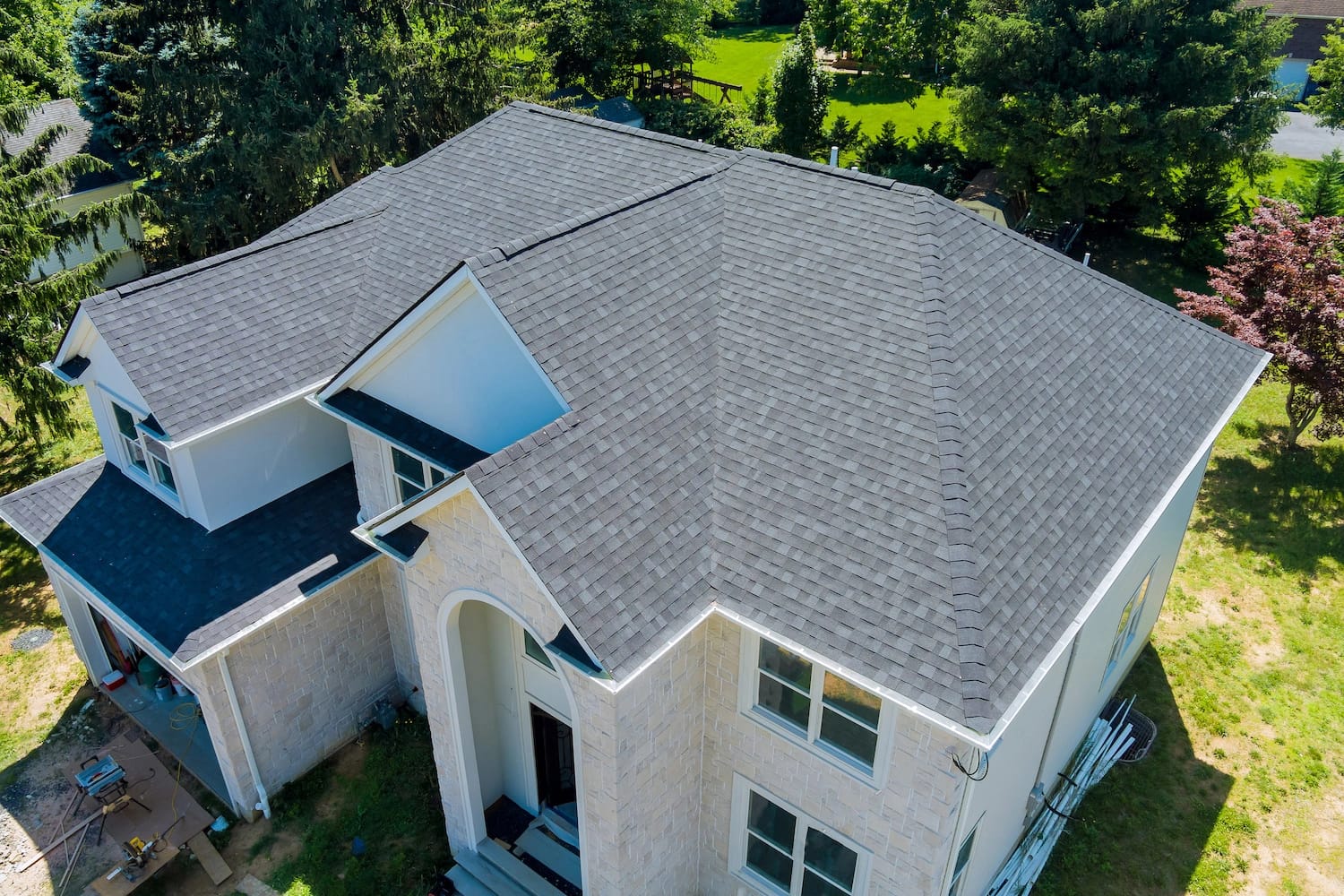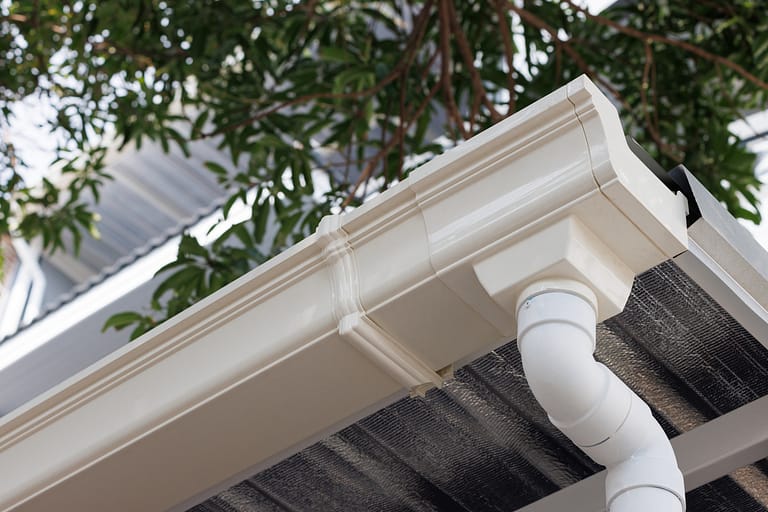Your roof stands as the steadfast guardian of your home, shielding you from the elements and providing comfort and security. But like all things, it’s not immortal. If you’ve found yourself wondering how long does a roof last, you’ve come to the right place. It’s crucial to understand:
- The lifespan of your roof
- The signs of wear and tear
- How to choose the right material
In this blog, we delve into the intricacies of roof lifespan, materials, maintenance, and roof replacement costs.
Average Lifespan of a Roof by Material
The life expectancy of your roof is hugely impacted by the material that your roof is comprised of.
1) Asphalt Shingles:
Asphalt shingles, the most common roofing material, typically last 15 to 30 years. Factors influencing longevity include climate, installation quality, and maintenance.
High-quality asphalt shingles with proper installation and maintenance can extend their lifespan closer to 30 years.
2) Metal Roofing:
Metal roofs are renowned for their durability, lasting anywhere from 40 to 70 years or more. They resist corrosion, cracking, and other common issues associated with traditional roofing materials. Proper installation and occasional maintenance are key to maximizing the lifespan of a metal roof.
3) Wood Shingles and Shakes:
Wood shingles and shakes offer a rustic charm but require diligent maintenance. Their lifespan ranges from 20 to 40 years, depending on climate and maintenance.
Regular inspections, treatments, and repairs can extend their lifespan towards the higher end of the spectrum.
4) Clay or Concrete Tiles:
Clay or concrete tiles boast exceptional longevity, often lasting 50 years or more. They are resistant to fire, insects, and rot, contributing to their durability. Adequate structural support is crucial due to their weight, and proper installation ensures their longevity.
5) Slate Roofing:
Slate roofing is renowned for its unmatched durability, lasting over a century in many cases. It’s resistant to fire, rot, and insects, making it a premium choice for longevity. However, slate roofs require professional installation and periodic inspections to maintain their integrity.
How to Extend the Lifespan of Your Roof
If you want to get the most out of your roofing system, follow these steps!
- Regular Inspections: Schedule annual inspections to identify potential issues early.
- Prompt Repairs: Address minor damages promptly to prevent them from escalating.
- Clean Gutters: Clear debris from gutters to prevent water backup and roof damage.
- Trim Trees: Trim overhanging branches to prevent them from damaging the roof during storms.
- Proper Ventilation: Ensure proper attic ventilation to prevent moisture buildup and prolong shingle life.
- Avoid Walking: Minimize foot traffic on the roof to prevent damage to shingles or tiles.
- Professional Maintenance: Hire professional roofers for periodic maintenance and repairs.
9 Factors That Age Your Roof Faster
While all roofs have an average lifespan, certain factors can speed up the aging process, leading to the need for a roof replacement. Here are some things to watch out for:
1) Poor Ventilation:
Inadequate ventilation in the attic can lead to heat and moisture buildup, causing shingles to deteriorate prematurely. Proper attic ventilation is essential for maintaining the temperature and moisture levels, thereby prolonging the lifespan of your roof.
2) Improper Installation:
Incorrect installation techniques, such as using too few nails or improper flashing, can compromise the integrity of your roof and shorten its lifespan. It’s crucial to hire experienced and reputable contractors who adhere to industry standards to ensure proper installation.
3) Lack of Maintenance:
Neglecting routine maintenance, such as cleaning gutters, removing debris, and inspecting for damage, can accelerate roof deterioration. Regular maintenance helps identify issues early on and prevents minor problems from escalating into major repairs or replacements.
4) Harsh Weather Conditions:
Extreme weather events, such as heavy rain, hailstorms, high winds, and snow accumulation, can take a toll on your roof over time. While no roof is immune to weather damage, choosing durable materials and performing timely repairs can mitigate the effects of harsh conditions.
5) Overhanging Trees:
Trees with overhanging branches pose a risk of damage to your roof, especially during storms or windy conditions. Falling branches can cause punctures, scratches, or dislodged shingles, leading to roof leaks and water damage. Trim trees regularly to minimize the risk of roof damage.
6) Moss and Algae Growth:
Moss, algae, and lichen growth on your roof not only detract from its appearance but also trap moisture, leading to premature deterioration of shingles. Regularly remove moss and algae and consider installing zinc or copper strips to prevent their regrowth.
7) Foot Traffic:
Excessive foot traffic on the roof, whether from homeowners inspecting for damage or contractors performing repairs, can cause damage to shingles, flashing, and other roofing components. Minimize foot traffic to preserve the integrity of your roof.
4) Poor Drainage:
Improper drainage systems, such as clogged or inadequate gutters and downspouts, can lead to water pooling on the roof surface. Standing water can accelerate deterioration, cause leaks, and promote the growth of mold and mildew. Ensure proper drainage to prevent water damage.
5) Nearby Pollution:
Proximity to industrial areas, highways, or other sources of air pollution can accelerate roof aging by causing chemical degradation of roofing materials. Regular cleaning and maintenance can help mitigate the effects of pollution on your roof.
By being aware of these factors and taking proactive measures to address them, you can help prolong the lifespan of your roof and ensure its continued protection of your home. Regular inspections, proper maintenance, and timely repairs are key to preserving the integrity and longevity of your roof for years to come.
Signs That You Need a Roof Replacement
Eventually, there’s no avoiding it. You need a roof replacement. Here are the signs that it’s time to bite the bullet and call your roofing contractor.
- Age: If your roof is nearing or past its expected lifespan, it’s time to consider a replacement.
- Curling or Buckling Shingles: Warped or curled shingles indicate weathering and potential water damage.
- Missing Shingles: Missing shingles compromise the integrity of the roof and require immediate attention.
- Granule Loss: Excessive granule loss from asphalt shingles signifies deterioration.
- Leaks: Water stains on ceilings or in the attic indicate roof leaks and require prompt action.
- Sagging: Sagging areas on the roof suggest structural damage and necessitate immediate inspection.
- Energy Bills: A sudden increase in energy bills may indicate poor roof insulation or ventilation, signaling the need for replacement.
The Cost to Replace a Roof
The cost of replacing a roof varies widely depending on factors such as:
- Roof size and complexity
- Choice of materials
- Labor costs in your area
- Additional features like skylights or chimneys
On average, a roof replacement can range from $5,000 to $15,000 or more for a typical single-family home. Premium materials like slate or metal may push the cost higher, while simpler materials like asphalt shingles tend to be more affordable.
How to Choose the Right Roofing Material
Not Sure which roofing materials are right for your home? Here are some of the considerations to keep in mind:
- Consider Climate: Choose materials that can withstand the prevalent weather conditions in your area.
- Durability: Assess the lifespan and durability of different materials to match your long-term needs.
- Aesthetic Appeal: Select a roofing material that complements the architectural style of your home.
- Maintenance Requirements: Evaluate the maintenance needs of each material and choose one that aligns with your preferences and capabilities.
- Budget: Determine your budget and explore roofing options that offer the best balance of cost and quality.
- Energy Efficiency: Some roofing materials, like metal or reflective coatings, can improve energy efficiency and reduce cooling costs.
- Consult Professionals: Seek guidance from roofing contractors or professionals to understand the pros and cons of each material and make an informed decision.
Learn More About Your Roof’s Life Expectancy!
Your roof is more than just a covering; it’s a vital component of your home’s structural integrity and comfort. By understanding the lifespan of different roofing materials, implementing proper maintenance practices, and knowing when to replace your roof, you can ensure its longevity and protect your investment. Whether you opt for traditional asphalt shingles, durable metal roofing, or timeless slate tiles, choosing the right material and caring for your roof diligently will safeguard your home for years to come.
Ready to learn more about how to take care of your aging roof? Contact G Cannon today to get the information you need!








